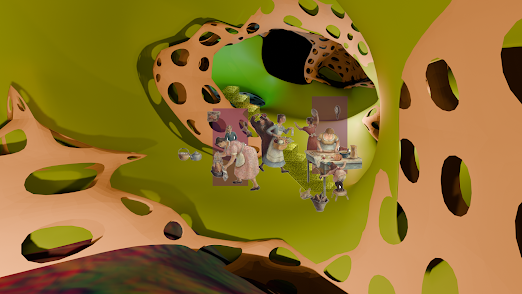Dunes, a complex structure of nature, have a unique dynamic geology. The Mad Palace, on the other hand, aims to build an architecture by combining the complex order of nature with the moods of human nature. While witnessing the unpredictability of the complexity of the environment built by human impact on nature and nature's impact on human beings in dune areas, it offers an invitation to people to discover their potential to self-organize and reveal themselves.
Space begins to weave itself with the sensory nature of binding,
like a Mad Palace speculating on the movement of grains of sand.
The spaces that emerge from each binding, association and knot are created by
matching a sensation with the predicted prevailing direction of the wind.
As in a stochastic system, the spaces formed by
these parameters produce different results, i.e. different spaces,
each time, even if the same process is performed under the same conditions.
lab.02//In this work, I study natural dune formations, investigating how sand grains move and form under the influence of wind and other environmental factors. My goal is not only to replicate these natural forms, but also to understand the fundamental rules governing the formation of dunes. This research allows me to better understand dune dynamics and how they evolve over time.
As these modules come together, the quest for spaces has become an even more complex issue. The search for enclosed, semi-open, and open spaces that this shell, constructed with the parameters of nature, can create plays a significant role in the project. How this shell will integrate with the ground or how it can be temporary has also become important discussion topics in this context. As the project progresses, it is envisaged that the foundation needs to be more robust and that it will be built by spraying concrete onto a mold, leaving gaps in between.
Considering that the envisaged shell might have insufficient load-bearing capacity or that there are areas that need to be protected from sandstorms, the parts where there is no sprayed concrete were designed with the module shell system using Phase-change Materials (PCM). This innovative system is resistant to Konya's harsh weather conditions and provides the comfort zone, which is not a concern for a madman, in the desired spaces through passive climate control. PCM material has a structure that changes phase according to the ambient temperature, thereby storing or releasing thermal energy. Thus, energy savings are achieved, and the temperature balance of the interior spaces is maintained.
The events and situations of the discovered spaces, or rather their forms, vary in fragments. This variability emphasizes the dynamic and organic nature of the project, showcasing each module's ability to adapt to different needs and conditions. Hence, the project is designed not only as a static structure but also as an organism constantly evolving and interacting with its environment.
In this context, a structure system has been created where nature and humans can coexist, being both durable and flexible. This system represents an innovative approach that can inspire future architectural projects.


















